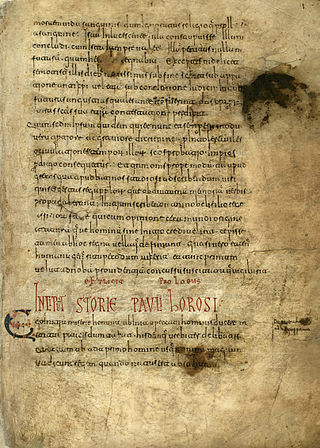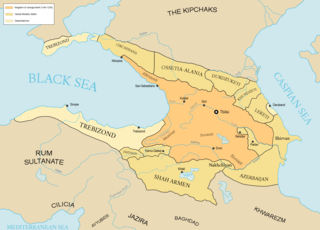Related Research Articles

The terms anno Domini (AD) and before Christ (BC) are used to label or number years in the Julian and Gregorian calendars. The term anno Domini is Medieval Latin and means 'in the year of the Lord', but is often presented using "our Lord" instead of "the Lord", taken from the full original phrase "anno Domini nostri Jesu Christi", which translates to 'in the year of our Lord Jesus Christ'. The form "BC" is specific to English and equivalent abbreviations are used in other languages: the Latin form is Ante Christum natum but is rarely seen.
A chronicle is a historical account of events arranged in chronological order, as in a timeline. Typically, equal weight is given for historically important events and local events, the purpose being the recording of events that occurred, seen from the perspective of the chronicler. A chronicle which traces world history is a universal chronicle. This is in contrast to a narrative or history, in which an author chooses events to interpret and analyze and excludes those the author does not consider important or relevant.
Partholón is a character in medieval Irish Christian pseudo-history, who is said to have led one of the first groups to settle in Ireland. 'Partholón' comes from the Biblical name Bartholomaeus (Bartholomew), and may be borrowed from a character who appears in the Christian pseudo-histories of Saints Jerome and Isidore of Seville.

A mappa mundi is any medieval European map of the world. Such maps range in size and complexity from simple schematic maps 25 millimetres or less across to elaborate wall maps, the largest of which to survive to modern times, the Ebstorf map, was around 3.5 m in diameter. The term derives from the Medieval Latin words mappa and mundus (world).
The Cursor Mundi is an early 14th-century religious poem written in Northumbrian Middle English that presents an extensive retelling of the history of Christianity from the creation to the doomsday. The poem is long, composed of almost 30,000 lines, but shows considerable artistic skill. In spite of the immense mass of material with which it deals, it is well proportioned, and the narrative is lucid and easy.
Lebor na hUidre or the Book of the Dun Cow is an Irish vellum manuscript dating to the 12th century. It is the oldest extant manuscript in Irish. It is held in the Royal Irish Academy and is badly damaged: only 67 leaves remain and many of the texts are incomplete. It is named after an anachronistic legend that it was made from the hide of a dun cow by Saint Ciarán of Clonmacnoise.

The Six Ages of the World, also rarely Seven Ages of the World, is a Christian historical periodization first written about by Augustine of Hippo circa AD 400.

Anno Mundi, abbreviated as AM or A.M., or Year After Creation, is a calendar era based on the biblical accounts of the creation of the world and subsequent history. Two such calendar eras have seen notable use historically:

The Hereford Mappa Mundi is a medieval map of the known world, of a form deriving from the T and O pattern, dating from c. 1300. Archeological scholars believe the map to have originated from eastern England in either Yorkshire or Lincolnshire before it was transported westward to the Hereford Cathedral in Herefordshire where it has remained ever since. It is displayed at Hereford Cathedral in Hereford, England. It is the largest medieval map still known to exist. A larger mappa mundi, the Ebstorf map, was destroyed by Allied bombing in 1943, though photographs of it survive.
A number of Irish annals, of which the earliest was the Chronicle of Ireland, were compiled up to and shortly after the end of the 17th century. Annals were originally a means by which monks determined the yearly chronology of feast days. Over time, the obituaries of priests, abbots and bishops were added, along with that of notable political events. Non-Irish models include Bede's Chronica maiora, Marcellinus Comes's Chronicle of Marcellinus and the Liber pontificalis.

The Chronicle of Ireland is the modern name for a hypothesized collection of ecclesiastical annals recording events in Ireland from 432 to 911 AD.

The Códice de Roda or Códice de Meyá is a medieval manuscript that represents a unique source for details of the 9th and early 10th century Kingdom of Navarre and neighbouring principalities. It is currently held in Madrid as Real Academia de la Historia MS 78.
Dáibhí Iarla Ó Cróinín is an Irish historian and authority on Hiberno-Latin texts, noted for his significant mid-1980s discovery in a manuscript in Padua of the "lost" Irish 84-year Easter table. Ó Cróinín was Professor of History at NUI Galway and Member of the Royal Irish Academy. He specialises in the history of Ireland, Britain and Europe during the Middle Ages and Hiberno-Latin texts.

The Annals of Quedlinburg were written between 1008 and 1030 in the convent of Quedlinburg Abbey. In recent years a consensus has emerged that it is likely that the annalist was a woman. The annals are mostly dedicated to the history of the Holy Roman Empire; they also contain the first written mention of the name of Lithuania ("Litua"), dated to March, 1009. The original document has disappeared, surviving only as a 16th-century copy held in Dresden, but its contents endure as a scholarly resource.
Oxford, Bodleian Library, Rawlinson B 502 is a medieval Irish manuscript which presently resides in the Bodleian Library, Oxford. It ranks as one of the three major surviving Irish manuscripts to have been produced in pre-Norman Ireland, the two other works being the Lebor na hUidre and the Book of Leinster. Some scholars have also called it the Book of Glendalough, in Irish Lebar Glinne Dá Locha, after several allusions in medieval and early modern sources to a manuscript of that name. However, there is currently no agreement as to whether Rawlinson B 502, more precisely its second part, is to be identified as the manuscript referred to by that title.
Sex aetates mundi may refer to
Lebor Bretnach, formerly spelled Leabhar Breathnach and sometimes known as the Irish Nennius, is an 11th-century historical work in Gaelic, largely consisting of a translation of the Historia Brittonum. It may have originated in Scotland, although it has traditionally been attributed to the Irish poet Gilla Cóemáin.

Nicopsis, Nikopsis, or Nikopsia was a medieval fortress and town on the northeastern Black Sea coast, somewhere between the towns of Tuapse, Russia, and New Athos, Georgia. It features in the medieval Greek and Georgian sources as a Byzantine outpost and then as the northwestern extreme of the Kingdom of Georgia. A center of Christianity in the region known as Zichia, Nikopsis was at times a Byzantine bishopric and was believed to be a burial place of the apostle Simon the Canaanite.

The Frankish Table of Nations is a brief early medieval genealogical text in Latin giving the supposed relationship between thirteen nations descended from three brothers. The nations are the Ostrogoths, Visigoths, Vandals, Gepids, Saxons, Burgundians, Thuringians, Lombards, Bavarians, Romans, Bretons, Franks and Alamanni.
"Dúan in chóicat cest" is a medieval school poem in Middle Irish, also known by its incipit "Iarfaigid lib cóecait cest."
References
- ↑ Bart Jaski, "Sex Aetates Mundi", in Encyclopedia of the Medieval Chronicle, 2010, p. 1353.
- ↑ Patrick Wadden (2012), Theories of National Identity in Early Medieval Ireland (PhD dissertation), Oxford University, UK, pp. 209–232.